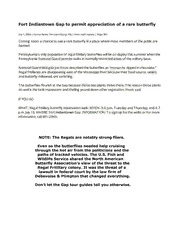
2004-StonyCreek-Gap-RegalButterflyWalk-PatriotNewsHarrisburgPa PDF
Preview 2004-StonyCreek-Gap-RegalButterflyWalk-PatriotNewsHarrisburgPa
Fort Indiantown Gap to permit appreciation of a rare butterfly 1912008 | Pauioe News, The Masso AI | From ta repecs | Fage S01 Coming sean: a chance to see a rare butterfly in a place where most members of the pubic are banned, Pennsylvania's only population of regal fitilary butterflies will be on display this summer when the Pennsylvania National Guard permits walks in normally restricted areas of the military base. National Guard biologist oe Hovis described the butterflies as “monarchs dipped in chocolate.” Regal rtilaries are disappearing east of the Mississippi River because theirfood source, violets and butterfly milweed, are vanishing, ‘The butterflies flourish at the Gap because those ewo plants thrive there, The reason those plants do welis the tank maneuvers and sheling pound down other vegetation, Hovis said. IFyouco WHAT: Regal ftilary butterfly observation walk, WHEN: 3-6 pum, Tuesday and Thursday, and 4-7 pam.July 13, WHERE: Fort Indiantown Gap. INFORMATION: To sign up for the walks or for more information, call 861-2929, NOTE: The Regals are notably strong fliers. Even so the butterflies needed help cruising through the hot air from the politicians and the paths of tracked vehicles. The U.S. Fish and Wildlife Service shared the North American n's view of the threat to the lary colony. It was the threat of a lawsuit in federal court by the law firm of Debevoise & Plimpton that changed everything. Don't let the Gap tour guides tell you otherwise. Rare butterflies find home on the range September 12,2008 | Patrockews, The Morrisburg, PAI | ALMNALOFOuw Letaon Bure | Page AE This is the place, on a few grassy fields in the northern Lebanon County hills, where the Eastem regal frtilary butterfy & making ts last stand, The butterflies depend on the good willof the Pennsylvania National Guard and the efforts of The ‘Nature Conservancy, a national environmental group, to maintain their limited habitat. As far as anyone knows, they exist nowhere else. (Ona summer day, they appear to be holding their own. Butterflies with the regals' characteristic bright orange wings with chocolate brown borders can be seen fitting about the butterfly mikweed plants on a Gap field, Ithasn’t been that long since regals lke these, an Eastem subspecies of the more common regal frtilaries of the Plains, were much more widespread. AAs recently as the 1980s, regals had been spotted near Gettysburg and in Chester County. ‘Butin those places and others along the East Coast, the last populations of the regaks were, as The Nature Conservancy's Betty Ferster put it, "winking out.” Regal frilaies thrive in grasslands and have survived in Pennsylvania for thousands of years, ‘moving from place to place as clearings created by Ightning or humans have appeared, then disappearing as woodlands ance again encroached, Butin the last fewdecades, remaining grasslands disappeared under homes, businesses and farms. However, at Fort Indiantown Gap, a miltary base since the early 1930s, the land lay undeveloped but had enough activity to keep it from reverting to woodland. study by the conservancy in 1992 estimated about 2,000 regal iitilaries at the Gap. Ferster said there are now 1,000 to 1,200, a number she said has been stable since the conservancy established a fulltime office here in January 1998. In August 1999, the Guard set aside 157 acres for the butterflies. In 2002, that was increased to 220 acres. The butterflies remain in a precarious position risking the possibilty that a single disaster could Wipe them out in one swipe. Long-range plans cal for reintroducing the butterflies in other areas, possibly at Gettysburg National Miltary Park. But the conservancy isn't rushing, "You can't ust release the butterflies inary big open file” said Pat Mclihenny, the Nature Conservancy's land supervisor at the Gap. Trying to figure out what kind of field wills upport the regals fs one of the canservancy’s tasks. Some things are cear. Regal caterpilars need vivlets ~ arrowdea! violets at the Gap. The adult butterflies need a variety of nectar plants, inclucing the mikweed. There are 2 number of fielés at the Gap, beyond the officially protected ates, thal would seem Lo fil he bill bul Ferster said the butterflies donit go there. Inthe meantime, miftary training is banned on the lend set asi¢e for the kutterfies. Some sdsturbance inthe area might be OX, Fersier said, but too much woud destroy the regals. "We don't krow how much too much s," she sai. ALWINN: 272-3759 or [email protected] INFOBOX: ACLOSER LOOK Other projects atthe Gap: Bird survey and monitarng: Stucies the effects of training using 2 database of species, aburidance and dversity. *Snake moritoring and management: Studies amphibians’ breeding, including timber rattlesnakes, copperheads, turtes and swemp-dwveling salrmanders. ‘Insect inventory, monitoring and management project: Studies insect links in the ecosystem as food sources, polinators and dsease cartiers. *Airgort wiclfe hazard control project: Manages hazards to fig ht facies. *Macrorvertebrate surveys Collects data on aquatic insects, water qualty and habitat. Stream water quality and groundwater mapping: Monitors stream flow and sediment where ‘Manade Creek and Indiantown Run keave the hase
